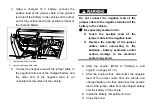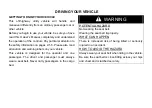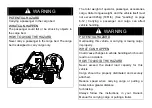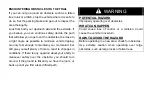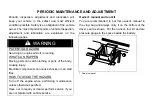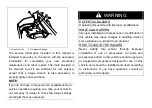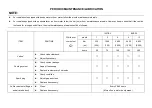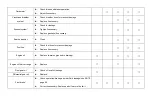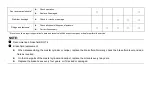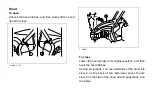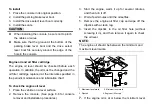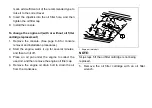
Before climbing the hill, first be sure you are operating
in low range 4WD or, if necessary, with 4WD Diff. Lock.
To climb a hill, you need traction, momentum, and
steady throttle.
Travel fast enough to keep your momentum going, but
not so fast that you cannot react to changes in the
terrain as you climb. Slow down when you reach the
crest of the hill if you cannot clearly see what is on the
other side? There could be another person, an obstacle,
or a sharp drop off.
If you start to lose traction or momentum when climbing,
and you decide you will be unable to continue, use the
brakes to come to a stop. Do not attempt to turn the
vehicle around. With your foot on the brake, look
behind you and plan your descent. Shift the drive select
lever in reverse so you can use the engine brake if
necessary to slow your descent. Release the brake and
begin to coast down the hill. Use engine braking as
much as possible, gently applying the brakes when
necessary.
GOING DOWNHILL
Check the terrain carefully before going down a hill.
When possible, choose a path that lets you drive your
vehicle straight downhill. Avoid sharp angles that could
allow the vehicle to pitch or roll over. Carefully choose
your path and drive no faster than you will be able to
react to obstacles that may appear.
WARNING
POTENTIAL HAZARD
Going down a hill improperly.
WHAT CAN HAPPEN
Could cause loss of control or cause the vehicle to
overturn.
HOW TO AVOID THE HAZARD
Always check the terrain carefully before you start
down any hill. Never go down a hill at high speed.
Avoid going down a hill at an angle that would cause
the vehicle to lean sharply to one side.
Go straight down the hill where possible.
Summary of Contents for SRU600
Page 2: ......
Page 10: ...LOCATION OF THE WARNING AND SPECIFICATION LABELS ...
Page 12: ... ...
Page 13: ... ...
Page 14: ...Unless you are 16 years old or more please do not operate this vehicle ...
Page 15: ...DESCRIPTION AND VEHICLE IDENTIFICATION ...
Page 91: ......
Page 122: ... SSR MOTORSPORTS INC ...
Page 123: ... ...


